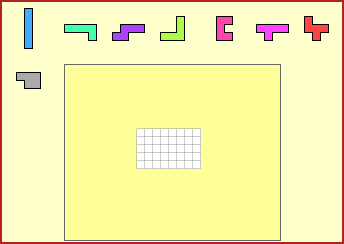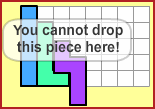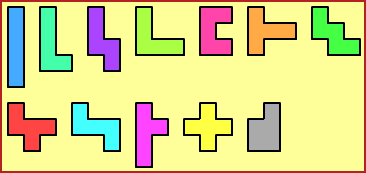|
Advertise on this site |
How To Play Tile PuzzlerOn this page you will find instructions on playing the Tile Puzzler games, as well as a brief description of each style of play. You may wish to open the following link so you can try the game while reading: Sample Pento Puzzler.About The Puzzle ScreenAs you look at the puzzle screen, you will see that the playing field is divided into two regions. First, there is a light yellow region around the edge of the playing field. This is the "bin". It is where you can place your unused puzzle pieces to get them "out of the way". Each of your puzzle pieces begin in this space. There is also a darker yellow region in the center, which is surrounded by a gray border. This region contains the target - a region colored white with gray grid lines. The object of the game is to rearrange your puzzle pieces in order to completely fill the target. Moving The Pieces When you are ready to pick up a piece, hover the mouse over the piece and click once. (Press and release the mouse button). Now you can move the puzzle piece around the board
simply by moving the mouse. Click the mouse a second time to drop the puzzle piece into place. If you attempt to drop the piece in an illegal position
(on top of another piece, off the edge of the game window, or partly in the target), you
will see a notice telling you that you can not place the piece there. When you are ready to pick up a piece, hover the mouse over the piece and click once. (Press and release the mouse button). Now you can move the puzzle piece around the board
simply by moving the mouse. Click the mouse a second time to drop the puzzle piece into place. If you attempt to drop the piece in an illegal position
(on top of another piece, off the edge of the game window, or partly in the target), you
will see a notice telling you that you can not place the piece there.Rotating And Flipping Most of the puzzle pieces can be transformed (placed in different orientations) by rotating or flipping them. This image shows a piece which
has eight transformations. The top four transformations are created by rotating only, and the bottom four transformations are created by flipping the piece and
then rotating.
Most of the puzzle pieces can be transformed (placed in different orientations) by rotating or flipping them. This image shows a piece which
has eight transformations. The top four transformations are created by rotating only, and the bottom four transformations are created by flipping the piece and
then rotating.In order to rotate a puzzle piece, you must have selected it by clicking it once. Now press the "R" key on your keyboard. This will rotate the piece clockwise 90 degrees. Each time you press "R", the piece rotates another 90 degrees. In order to flip a piece press the "F" key on your keyboard. Pressing "F" a second time returns the piece to its original orientation. Tri PuzzlersIn Tri Puzzlers, each puzzle piece is composed of three blocks. There are two possible shapes using three blocks. This kind of puzzle is especially nice for young children, since none of the pieces will ever require flipping. This means there are fewer possibilities to consider. A Tri Puzzler Tetra PuzzlersThe puzzle pieces in a Tetra Puzzler will look very familiar to anyone who has played Tetris. These puzzle pieces are composed of four tiles. Tetra Puzzles are more challenging than Tri Puzzlers, but certainly are not the most difficult puzzles on the site! A Tetra Puzzler Pento PuzzlersThe Pento Puzzlers are definitely more challenging than both the Tri Puzzlers and the Tetra Puzzlers. The puzzle pieces are composed of five tiles. There are twelve different shapes, and many of them can be transformed both by rotation and by flipping. A Pento Puzzler Free Style PuzzlersIn Free Style Puzzlers the puzzle creator is not limited to the standard Tri, Tetra, or Pento puzzle pieces. Any imaginable piece can be created - provided it is not wider or taller than five tiles. The following image shows some examples. Note that the image contains only four puzzle pieces. Both the green piece and the yellow piece contain non-adjacent tiles. Clicking on one section of the tile selects the entire tile. A Free Style Puzzler Overlap PuzzlersOverlap Puzzlers can be the most fiendishly difficult puzzles. In these puzzles, there may be more puzzle pieces than will fit in the target region. What is the trick to solving these? The trick is that the pieces are allowed to overlap, provided they overlap on tiles which are the same color. Consider the following two puzzle pieces: Both of these puzzle pieces contain blue tiles and a green tile. There are many ways in which these tiles could be placed in relation to each other. The image below shows four of those ways. In the first configuration shown, the pieces do not overlap at all. In the second, they overlap on two blue tiles. In the third they overlap on three blue tiles and one green tile. In the fourth, they overlap on one blue and one green tile.  An Overlap Puzzler Additional FeaturesEventually some extra features will be added to the games, including the following:
Quick Links
|